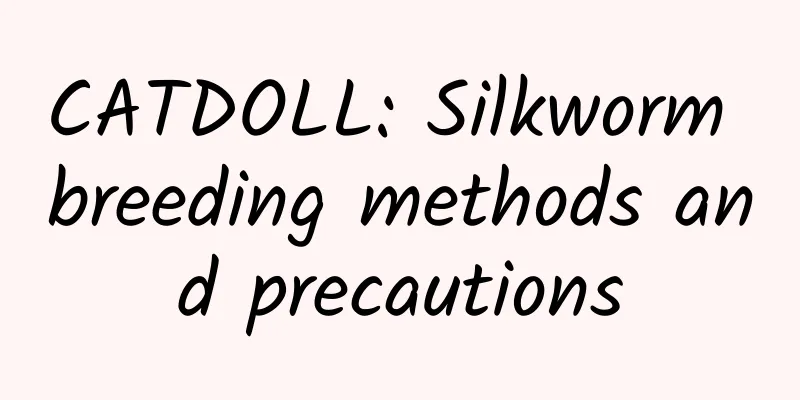CATDOLL : CATDOLL: Silkworm breeding methods and precautions

Silkworm breeding methods and precautions1. Breeding preparation: Disinfect the silkworm room, accelerate the growth of silkworm eggs, and collect the ants after photosensitive hatching. 2. Rearing of young silkworms: 1st, 2nd and 3rd age silkworms are fed with the 3rd, 4th and 5th-6th leaves from the top bud of the mulberry tree respectively. The amount of mulberry leaves required for each silkworm is 1kg, 2kg and 10-12kg respectively. 3. Raising adult silkworms: Choose the 7th to 15th leaves from the top bud to feed, and the amount of mulberry used should account for more than 95% of the amount used during the entire age. 1. Preparation before breeding 1. Disinfection (1) About 7 days before raising silkworms, use 1% chlorine to spray and disinfect, spraying 0.25 kg of liquid per square meter. After spraying, seal the silkworm room for more than 24 hours. (2) In addition to the silkworm room, the environment around the silkworm room also needs to be sprayed with medicine for disinfection. 2. Accelerating the growth of green (1) Accelerating the growth of silkworm eggs refers to the process of using artificial methods to protect the activated silkworm eggs in a suitable environment to promote the smooth development of the embryos until the silkworm eggs turn green and the larvae hatch. Generally speaking, it takes about 10-11 days to accelerate the growth of silkworm eggs in spring and about 8-9 days in summer and autumn. (2) Specific operation: Place the silkworm eggs in a disinfected silkworm room. On the 1st to 4th day, the room temperature is maintained at 22°C, and the difference between dryness and wetness is controlled at about 3-4°C. From the 5th day to the hatching period, the room temperature is maintained at 25-26°C, and the difference between dryness and wetness is controlled at about 2-3°C. During this period, when about 20-30% of the silkworm eggs on a sheet of silkworm eggs are green, use black cloth to block light and provide dark protection (supplementary greening). (3) When accelerating the growth of green tea, it is necessary to prevent it from being exposed to the sun and avoid a hot and humid environment. 3. Collect ants (1) Counting from the day of incubation (usually around the eighth day after the silkworm eggs are shipped out of the warehouse), the black cloth is removed at around 5 a.m. on the third day and the light is turned on for photosensitive incubation. (2) After 3-4 hours of exposure, harvest the silkworms (harvest silkworms at 9 am in spring and 7-8 am in summer and autumn). Specific operation method: Cut the first unfolded leaf of mulberry tree into small cubes with a side length of 0.5 cm, and spread them on a dustpan lined with plastic film (the amount of leaves should be 5 times the amount of silkworms). Then, hold the silkworm seed paper in one hand and the silkworm chopsticks in the other hand, and evenly pat the back of the silkworm seed paper to let the silkworms fall onto the dustpan. Then, use goose feathers to scrape the silkworms and arrange them into a round shape. 2. Raising young silkworms (1-3 years old) 1. Temperature and humidity (1) If the silkworms are 1-2 years old, the indoor temperature should be controlled at around 26-27℃, and full dry-proof rearing should be adopted (i.e., cover the silkworms from above and pad them with plastic film). If the silkworms are 3 years old, the indoor temperature should also be controlled at around 26-27℃, and semi-dry-proof rearing should be adopted (i.e., only cover the silkworms without padding them with plastic film). (2) If the silkworms are 1-2 years old, the relative humidity in the room should be controlled at about 90%. If the silkworms are 3 years old, the relative humidity in the room should be controlled at about 85%. 2. Feeding (1) One-year-old silkworms are generally fed with the third leaf from the top bud of the mulberry tree. Each silkworm of each silkworm breed needs 1 kg of mulberry leaves (cut into small cubes for feeding, with a side length of 1.5 times the length of the silkworm body). (2) Second-instar silkworms are generally fed with the fourth leaf from the top bud of the mulberry tree. Each silkworm of each silkworm breed requires 3 kg of mulberry leaves (cut into small cubes for feeding, with a side length of 1.5 times the length of the silkworm body). (3) Three-year-old silkworms are generally fed with the 5th to 6th leaves from the top bud of the mulberry tree. Each silkworm needs 10 to 12 kg of mulberry leaves (cut into triangles for feeding). (4) Feed four times a day, at 7 a.m., 11 a.m., 4 p.m., and 10 p.m. 3. Sleep management (1) When the young silkworms turn white, their bodies shorten, and their bodies become tense and shiny, add nets to the mulberry trees to remove sand before they go to sleep. If some silkworms have already gone to sleep, but others have not, add nets to the mulberry trees again, lure the silkworms that have not gone to sleep up, and move them to another winnowing basket to continue feeding them until they go to sleep. (2) In the early stage of dormancy, the silkworm beds should be kept dry by sprinkling lime powder on them and keeping the relative humidity at around 80%. When the silkworms are about to hatch, the relative humidity in the room should be kept at around 85%. (3) When more than 95% of the sleeping silkworms have shed their skins, their heads have changed from grayish white to brown and have become noticeably larger. When the young silkworms crawl around looking for food, use tender mulberry leaves to feed them (the amount of mulberry leaves should be relatively small). 3. Raising adult silkworms (4-5 years old silkworms) 1. Temperature and humidity If it is a 4th-instar silkworm, the temperature is controlled at around 24-25°C, and the difference between dryness and wetness is 2-3°C. If it is a 5th-instar silkworm, the temperature is controlled at around 23-24°C, and the difference between dryness and wetness is 3-4°C. 2. Stocking density If the silkworm is in its 4th instar, during the peak feeding period, the maximum area of each silkworm egg can reach 14 square meters. If the silkworm is in its 5th instar, during the peak feeding period, the maximum area of each silkworm egg can reach 30-35 square meters. 3. Feeding (1) Generally, the 7th to 15th leaves from the top bud of the mulberry tree are selected for feeding. (2) The amount of mulberry trees consumed during the adult silkworm period accounts for more than 95% of the total amount consumed during the entire silkworm age, and the amount of mulberry trees consumed during the fifth instar period accounts for about 85% of the total amount consumed during the entire silkworm age. (3) On the 1st to 2nd day or the 5th to 7th day of the 5th instar, the amount of mulberry leaves given should be strictly controlled so that the silkworms have just finished eating the last mulberry leaves. During the 3rd to 6th day, the silkworms should be fully fed. 4. Management (1) During the period of silkworm rearing, use fresh lime powder to disinfect silkworm bodies and silkworm seats every morning. If it is rainy, spread it twice a day. (2) After about 6-7 days, the 5th-instar silkworms stop eating mulberry leaves and excrete a large amount of soft green feces. Their chests gradually become transparent, their bodies become slightly soft and waxy yellow, and their heads swing left and right. At this time, select 3-4 square clusters and place them horizontally in an alternating pattern. Sprinkle the mature silkworms evenly on the clusters, and hang the clusters after the silkworms have settled down. During this period, the temperature in the clusters is controlled at around 24°C and the relative humidity is controlled at around 85%. (3) The cocoons of spring silkworms are harvested and sold about 6 days after they are on the cocoons. The cocoons of summer and autumn silkworms are harvested and sold about 4-5 days after they are on the cocoons. How to raise silkworms correctly1. Feeding at the right temperature and humidity During the spring silkworm season, the temperature is low in the morning and evening, so it is necessary to adjust the temperature and humidity in the silkworm room by heating. The first-instar silkworm requires 82-830F, with a dry-wet difference of 0-0.50F; the second-instar silkworm requires 810F, with a dry-wet difference of 0.5-10F; the third-instar silkworm requires 790F, with a dry-wet difference of 1.5-20F; the fourth-instar silkworm requires 75-770F, with a dry-wet difference of 4-60F; the fifth-instar silkworm requires 74-760F, with a dry-wet difference of 5-60F. At the same time, pay attention to ventilation to prevent gas poisoning. 2. Use leaves reasonably, and eat good mulberry and potato On the day of harvesting, pick yellowish green mulberry leaves; pick tender green leaves for the first instar; pick leaves that will turn dark green for the second instar. You can also use three-eye leaves for the second mulberry harvest after the leaves open, which not only improves the efficiency of leaf picking, but also promotes the continued growth of new leaves, thereby increasing the yield of mulberry leaves; in the late fifth instar, send fingers to cut leaves while eating, and cut them after eating. The size of the leaves cut by the young silkworms is a square leaf twice the square of the silkworm body. The thickness of the mulberry leaves is 1.5-2 layers for the first instar, 2-2.5 layers for the second instar, and 2.5-3 layers for the third instar. During the adult silkworm period, especially in the middle and late fifth instars, it is necessary to ensure that the silkworms are fully fed and to arrange the amount of mulberry leaves reasonably. Generally, the amount of seeds used in the first two days of the fourth instar is about 55 kilograms, about 50 kilograms on the third day, and about 35 kilograms on the fourth day. The first three days of the fifth instar require 200-230 kilograms of mulberry, about 800 kilograms of mulberry on the 4th to 7th day, and more than 100 kilograms of mulberry on the 8th to 9th day. 3. Promoting the use of porous film to cover the Polyethylene plastic film is used for silkworm rearing. Generally, the 1-2 instar silkworms are covered on the top and padded on the bottom, with the four sides folded; the 3 instar silkworms are only covered without padding. Do not cover during sleep to ensure that the silkworm seats are dry and sleep evenly. In rainy and humid weather, the film can be removed earlier. Sometimes water droplets will appear on the cover film, so you can cover it on the other side after feeding the mulberry trees. 4. Advanced expansion and uniform seating Whether the work of expanding and leveling the cocoons is done in time directly affects the yield and quality of silkworm cocoons. Especially for young silkworms, the temperature is high and the growth rate is fast, so it is even more important to do the work of expanding and leveling the cocoons in advance. If the silkworm heads are unevenly distributed or too dense, it is easy to cause large and small silkworms, and the silkworms will sleep and wake up at different times, which will affect the breeding of adult silkworms. The work of expanding and leveling the cocoons should also be done in time during the adult silkworm period. 5. Strengthen soil treatment and remove sand in time Before sleeping, you should choose tender mulberry leaves to feed silkworms. If there are late sleeping silkworms, you should add nets to raise them. Keep the silkworm bed quiet during sleeping, and the temperature should be 1~20F lower than when feeding mulberry. When most of the silkworms have light brown heads, their head and thorax are raised and swinging left and right, showing a state of seeking food, it is the right time to feed them. The leaves for feeding should be ripe and tender. Generally, it is better to feed about 50% of the peak feeding period before the first feeding of mulberry. Too much silkworm feces and residual mulberry on the silkworm bed are easy to ferment, and steaming heat is conducive to the reproduction of pathogens and viruses. The sand should be removed in time. Usually, the sand is not removed in the first instar; it is removed once when the second instar is awake and when it is asleep; and once when the third instar is awake, during the middle and during the sleep. The adult silkworms eat a lot of mulberry and excrete a lot of feces, so the silkworm feces should be removed in time. 6. Do a good job in disease and virus prevention Normally, 1-3-year-old silkworms are disinfected with anti-rigidity powder once a day, and 3-7-year-old bran is used to stop mulberry during dormancy. In the adult silkworm stage, anti-rigidity powder is used to disinfect the silkworm body when the silkworms are picked up, and fresh lime powder is sprinkled on the silkworm seat once a day to prevent the occurrence of viral diseases. Late-dormant silkworms and weak silkworms should be concentrated and isolated for breeding. For fly maggot disease, 500 times of feed can be added every other day or 300 times of silkworm fly killing liquid can be sprayed on the body starting from the second day of the 4th order or the second day of the third and 5th order, and once again before clustering. As for preventing bacterial silkworm diseases, the 4th order of feeding should be fed with norfloxacin liquid. When the disease occurs, it can be added several times continuously, and once every other day thereafter, preferably at noon on a sunny day. No feeding is required before dormancy and the late 5th order. Anti-toxic work should also be done during silkworm rearing. After the mulberry leaves are collected, a trial feeding should be carried out to minimize unnecessary losses. 7. Strengthen cluster management and improve cocoon quality It is recommended to use the square cluster outdoor pre-hanging indoor cocooning technology. The mature silkworms must go up the mountain in unison. Molting hormone should be used when the silkworms are 5-10% mature. Use 2 sticks per seed. The method is: dilute each stick of molting hormone with 2 kg of cold boiled water, spray it on 20 kg of mulberry leaves to feed the silkworms once. After feeding, the silkworms can mature and go to the cluster after about 10 hours. After the cluster is put on, first hang the square cluster in a pre-built shaded, rainproof and windproof place, and fully discharge the silkworm urine outdoors. After hanging, turn the cluster upside down and hang it again every 2-3 hours to increase the hole penetration rate. Move it indoors after entering the hole, protect it at 76-770F in the early stage, and protect it at 750F in the later stage of cocooning. The relative humidity in the cluster is generally 70-75%. Good ventilation of the cluster room is an important measure to improve the quality of cocoons. After the basic positioning of the cocoon, the door can be opened for ventilation, but strong wind cannot blow directly. After the cocoon shell turns white, all doors and windows must be opened to fully remove moisture and improve the quality of the cocoon. Preparation before raising silkworms: After planting mulberry leaves, prepare the silkworm room and silkworm tools; 7 days before raising silkworms, spray and disinfect with 1% strong chlorine, half a catty of liquid per square meter, and seal for more than 24 hours after spraying. At the same time, spray and disinfect the environment around the silkworm room. Accelerate the growth of silkworm eggs: About the eighth day after the silkworm eggs are taken out of the warehouse, you can see a small black dot at one end of the silkworm eggs, which is called "green dot". If 20% of the eggs on a sheet of silkworm eggs are green, use black cloth to block the light. Starting from the day of "green dot", remove the black cloth at 5 o'clock in the morning of the third day, turn on the light for light exposure and hatch. Collecting ants: After 3-4 hours of light exposure, the spring silkworms can be harvested at 9 am, and the summer and autumn silkworms can be harvested at 7-8 am. Method of collecting ants: Cut the first unfolded leaf of mulberry into 0.5 cm small cubes, use about 5 times the amount of leaves as ants, and sprinkle them on a dustpan lined with plastic film. Hold the silkworm seed paper in one hand and the silkworm chopsticks in the other hand, and pat the back of the silkworm seed paper evenly to make the ants and silkworms fall on the dustpan, then use goose feathers to scrape the ants and silkworms, and arrange them into a circle. Feeding of young silkworms: 1. Temperature and humidity adjustment: 1-3 years old are called young silkworms, and the environment required by young silkworms is high temperature and humidity. The suitable temperature for 1-2 years old is 26-27 degrees, and the relative humidity is not more than 90%; therefore, 1-2 years old silkworms are fully dry-raised, that is, covered with plastic film on the top and padded with plastic film on the bottom; 3 years old use semi-dry-raised, that is, only covered without plastic film, keep the temperature at 26-27 degrees, and the relative humidity at 85%. 2. Leaves for young silkworms: For the first-year silkworms, use the third leaf from the top bud of the mulberry tree, the leaf color is yellow with green, and one silkworm of silkworm seed uses 1 kg of leaves; for the second-year silkworms, use the fourth leaf from the top bud, the leaf color is green with yellow, and one silkworm uses 3 kg of leaves; for the third-year silkworms, use the fifth to sixth leaves from the top bud, the leaf color is light green and shiny, and one silkworm uses 10-12 kg of leaves; for the first- and second-year silkworms, cut the mulberry leaves into small cubes 1.5 times the length of the silkworm body, and for the third-year silkworms, cut the mulberry leaves into triangles for feeding. The amount of mulberry leaves fed each time should be controlled to leave a small amount of residual mulberry on the silkworm seat before the next feeding. 3. The number and time of feeding mulberry leaves: Feed 4 times a day, the time is: 7 am, 11 am, 4 pm, and 10 pm; young silkworms grow and develop quickly, and each feeding of mulberry leaves should be combined with expanding the seat. 4. Treatment before dormancy: (1) Desanding before dormancy: The body color of young silkworms turns white, their bodies shorten, their bodies become tense and shiny, some of the bodies of first-instar silkworms are covered with silkworm feces, and there are cases of second- and third-instar silkworms carrying silkworms. Then, nets can be added to the mulberry trees to remove sand before dormancy. (2) Raising silkworms: If some silkworms have fallen asleep and some have not, nets should be added to the mulberry trees again to draw the silkworms that have not fallen asleep up and move them to another winnowing basket to continue feeding until they fall asleep. 5. Protection during dormancy: In the early stage of dormancy, the silkworm seats should be dry. Lime powder should be sprinkled on the silkworm seats and the relative humidity should be maintained at 80%. When silkworms begin to wake up, the room should be kept humid and the relative humidity should be maintained at 85%. If the humidity is not enough, water can be sprinkled on the ground to replenish moisture. 6. Feeding after dormancy: When more than 95% of the dormant silkworms have shed their skins, their heads have turned from grayish white to brown, their heads have become significantly larger, and the young silkworms crawl around looking for food, they can be fed. The mulberry leaves for feeding should be slightly tender and the amount of mulberry leaves should be relatively small. Adult silkworm breeding: 1. Breeding method: 4-5 instar silkworms are adult silkworms, and the suitable growth temperature is 25 degrees. Silkworms have weak resistance to high temperature, humidity and carbon dioxide, eat a lot of mulberry, and excrete a lot. They can be raised on the ground indoors or on outdoor scaffolds. 2. Move silkworms to the ground: Clean the silkworm room, disinfect it with 1% bleaching powder, and after it is dry, sprinkle a layer of lime powder on the ground, feed the silkworms with a meal of leaves, and then move them to the ground for breeding. 3. Reasonable feeding of mulberry: 4-instar silkworms are the transition period from the growth of the silkworm body to the growth of the silk gland. If they are malnourished, it will affect the yield and quality. The mulberry leaves should be fresh and of good quality. 7-15 leaves under the top bud should be selected for feeding to achieve the goal of good mulberry. The amount of mulberry used by the 5th-instar silkworms accounts for about 85% of the total amount of mulberry used. This period is the key period for rational use of mulberry and improving the benefits of mulberry leaves. The feeding method of tight at both ends and loose in the middle is adopted: on the 1st-2nd day or the 5th-7th day of the 5th instar, the amount of leaves given should be strictly controlled until the silkworms have just finished eating the mulberry leaves next time; on the 3rd-6th day, the silkworms should be fully fed with good mulberry. Each time the leaves are fed, the silkworms are moved and the seats are expanded to keep the silkworm heads uniform. 4. Keep the silkworm seats clean: Use fresh lime powder to disinfect the silkworm bodies and seats every morning during the adult silkworm period. On rainy days, the humidity is high, so sprinkle lime powder twice a day to keep the ventilation and dryness. 5. Collecting cocoons on the cluster: After 6-7 days, the fifth-instar silkworms stop eating mulberry and excrete a lot of soft green feces. Their chests are transparent, their bodies are slightly soft and waxy yellow, and their heads swing left and right. At this time, select 3-4 square clusters and place them horizontally in alternating overlaps. Sprinkle the mature silkworms evenly on the clusters, and hang the clusters on hooks after the silkworms crawl. During the clustering period, good ventilation should be maintained, and the temperature in the cluster should be maintained at 24 degrees and the humidity at 85%. Generally, the cocoons can be collected and sold 6 days after the spring silkworms are on the clusters, and 4-5 days after the summer and autumn silkworms are on the clusters. Spring silkworm rearing technology Do a good job of disinfection before silkworm rearing to reduce the incidence of silkworms. Cleaning and disinfection before silkworm rearing is the most important part of the whole disease prevention and disinfection work, and it is also a prerequisite for high yield of silk cocoons. In order to improve the disinfection effect, the disinfection steps should be "sweep, wash, scrape, disinfect, and brush white"; six requirements are required in the disinfection process: the silkworm room should be cleaned, the silkworm tools should be cleaned, the medicine should be accurately prepared, the liquid medicine should be sprayed evenly, the room tools should be completely disinfected, and they should be kept well after disinfection. Do a good job of supplementing and accelerating greening to improve the hatching rate of one day. The quality of supplementing and accelerating greening is directly related to the hatching rate of one day. The majority of silkworm farmers should pay attention to supplementing and accelerating greening, mainly focusing on the control of temperature and humidity and shading. After the silkworm seeds arrive in the room, eggs should be spread in time, and the temperature should be controlled at 78-79H, and the humidity difference should be 2H. In the evening of the day before the ants are collected, the temperature should be raised to 80-81H, and the humidity difference should be 1H. At the same time, strict shading should be carried out during supplementing and accelerating greening to achieve the purpose of uniform hatching. Eliminate open flame heating to ensure the safety of silkworms and humans Open flame heating has great safety hazards: first, it is easy to cause carbon monoxide and other waste gas poisoning to breeders. Every year, silkworm farmers in our city are sent to the hospital for emergency treatment or even die due to open flame heating; second, it is difficult to control the temperature. When the temperature is too high, it affects the physical condition of silkworms and even kills them; third, it is easy to cause fire accidents. At the same time, this year's spring silkworm seeds are in short supply, and no seeds have been prepared in various places. If the losses caused by silkworm seeds poisoning or death by burning are caused, they will be irreparable. Therefore, in order to ensure the safety of human silkworms, we should vigorously promote hidden fire heating, implement hidden fire heating forms such as ground fire dragons, sky fire dragons, electric furnaces, and wall stoves, or transform open fire heating facilities, increase flues to the outdoors, and eliminate open fire heating; more than two people should be present when feeding silkworms in the silkworm room, so that they can take care of each other and rescue them in time when poisoning occurs; silkworm farmers who do not have small silkworm rearing facilities or have poor conditions and a relatively small number of silkworms should promote joint household breeding, implement centralized breeding of small silkworms, or hand them over to small silkworm companies for breeding; small silkworm rooms should be ventilated frequently to keep the indoor air fresh. Pay close attention to the weather and silkworm information, and work together to prevent fluorine. According to the forecast of the meteorological department, the precipitation in May this year is less, the temperature is higher, and the longest continuous sunny days can reach 7-8 days, which is a climate year with heavy fluorine pollution. Therefore, it is necessary to rely on the close cooperation of various departments to strengthen the prevention of fluorine in spring silkworms. First, we must implement the city government's measures to prevent fluoride during the spring silkworm season; second, pay close attention to the weather conditions and changes in silkworm information during the silkworm season. Once there are signs of fluoride poisoning, timely adopt agricultural fluoride prevention measures such as batch feeding, adjusting leaf positions, and washing leaves with lime water to reduce losses. It is recommended to adopt the core removal technology to improve the yield and quality of mulberry leaves. Core removal is to remove the tender heads of the new shoots of mulberry trees, which can promote the accelerated maturity of tender leaves and improve the yield and quality of mulberry leaves. The method is: about 10 days before the leaves are used, according to the leaf use plan of the mulberry garden, divide the pieces and remove the cores in batches. The degree of core removal: generally remove the tender heads that are shaped like magpies. Emphasis should be placed on disease and poison prevention to reduce losses caused by silkworm diseases and poisoning. During the breeding process, fresh lime powder, disease prevention No. 1, antibiotics and silkworm fly killers should be used to disinfect silkworm bodies and silkworm seats to minimize losses caused by silkworm diseases. At the same time, fresh lime powder, disease prevention No. 1 and other volatile and volatile agents should be stored in a sealed manner and tied tightly with the back bag mouth. When picking mulberry leaves from mulberry gardens adjacent to other crops, try them before eating them to prevent poisoning accidents caused by spraying pesticides on other crops. Strengthen ventilation and feed silkworms sparsely and fully. Since silkworms eat a lot of mulberry during the adult stage, have a lot of excrement, and are not resistant to high temperature and humidity, special attention should be paid to ventilation during the adult stage, and silkworms should be raised with doors and windows open, and sparse feeding should be achieved. During the three days of adult silkworms, each bed should be filled with a silkworm seat area of more than 40 square meters, and sufficient mulberry leaves should be provided to keep the silkworms fully fed. Do a good job in the cocooning process and improve the quality of spring cocoon production. Do a good job in the cocooning process of silkworms is an important measure to improve the quality of cocoon production. First, be aware of safety when selecting cocooning tools. In recent years, a few areas have had accidents in which a large number of silkworms did not cocoon due to the influence of residual pesticides in cocoon grass. Due to the outbreak of rice planthoppers last year, large-scale pest control of late rice caused an increase in the poisonous rice straw used for spring silkworms to cocoon. If we do not pay attention to the selection and treatment of cocoon grass, similar accidents are likely to occur. It is recommended to use high-quality cocooning tools such as square cocoons and plastic folding cocoons when cocooning; when using rice straw cocooning tools, try to use rice straw with less pesticide pollution, and use the relatively free time in the early stage of silkworm rearing to fully expose and dry it to the sun and try to expel residual pesticides. Second, strengthen ventilation in the cocoon. After all the mature silkworms have gone up the mountain and the cocoon net is formed, open the doors and windows of the cocoon room for ventilation, so that the silkworms can spit out all the cocoon silk substances, increase the amount of cocoon layers, and improve the quality of cocoons. Summer silkworm breeding technology Note: Prevent diseases and insect pests. Pay attention to disinfection before and during silkworm rearing. Prevent diseases from the 2nd instar and prevent flies and maggots from the 3rd instar. Prevent hot and stuffy weather. Prevent hot winds. Prevent hungry silkworms by feeding less and more frequently. Feed more at night when it is cool. Remove sand once a day from the 3rd instar. Collect ants on time at 8 or 9 in the morning and feed them as soon as they are collected. Feed cut leaves when silkworms are about to sleep. Feed less and more frequently. Add nets to stop silkworms from mulberry and let them sleep after they are full. The room temperature for young silkworms should not be higher than 30℃, and that for adult silkworms should not be higher than 27℃. Summer silkworms should be released more sparsely than spring silkworms. Give them appropriate leaves and feed them fully. The treatment of sleep and wake-up should be timely. Add sleep nets earlier than spring silkworms. If the silkworms are not developed properly, they should be raised in batches. Raise them in batches to shorten the time of stopping mulberry and let them sleep smoothly. Put them on the cocoon in time. When the silkworms are old, they should be selected in batches and put them on the cocoon sparsely. The key to summer silkworm breeding is to focus on good mulberry and full feeding, and flexibly apply the following techniques: prevent pests and diseases, prevent heat and starvation, pick up silkworms and remove sand frequently, collect ants early, feed early, expand the cocoon early, release silkworms sparsely, stop mulberry late, ensure uniform temperature in the silkworm room, uniform distribution of silkworms, uniform leaf feeding, uniform mulberry leaf age, and timely treatment of dormancy and cocooning. Techniques for improving silkworm cocoon quality Feeding silkworms with soy milk. When silkworms enter the peak feeding period of the fourth instar or the third day of the fifth instar, fresh soy milk can be sprinkled on fresh mulberry leaves to feed them. This can reduce the amount of mulberry, increase the weight of silkworms, and improve the rate of healthy pupae. Feeding method: Add 50 grams of soybean powder to 1 kilogram of warm water at 40-50℃, soak for 30 minutes, and make it into soy milk. Spray it evenly on 10 kilograms of fresh mulberry leaves, and feed them once at noon and 4 pm every day. Mosquito-repellent incense cannot be lit in the silkworm room. Mosquito-repellent incense has a toxic effect on insects such as silkworms and bees, so mosquito-repellent incense cannot be lit in the silkworm room in summer to repel mosquitoes. Mature silkworms quickly get on the cocoon. According to experiments, it takes 7-8 minutes to catch 500 mature silkworms on the cocoon by hand, but it only takes 1 minute to use a plastic silkworm net, and the silkworms are not easily injured. Specific method: When 5% of the silkworms are mature, add molting hormone to them (use 1 tube of Baume 40-degree molting hormone per seed, mix with 2 kg of cold boiled water, spray 15-20 kg of mulberry leaves, and feed them once to the silkworms so that the silkworms eat them all), so as to shorten the age of the silkworm group and promote the uniform maturity of the silkworms. Before putting them on the cocoon, first spread a plastic silkworm net on the silkworm seat. After half an hour, lift the silkworm net and move it to another silkworm plaque with plastic film, turn the silkworm net over, because the film is smooth, just shake it a few times and the mature silkworms will fall off. After the mature silkworms are collected, the quantitative cocooning method is adopted: each square cocoon has 156 holes, and 160 mature silkworms can be counted and put into a bowl or spoon first, and then each square cocoon is put into a bowl (spoon) of mature silkworms equivalent to the pre-counted number. Collect cocoons on the cocoon in time. When silkworms reach the fifth instar, they usually raise their front half bodies, swing from side to side, stop eating, their chests begin to become transparent, and they excrete soft feces and shrink their bodies. At this time, they should be caught and put on the cocoon. The best time to put summer silkworms and early autumn and mid-autumn silkworms on the cocoon is when 20-25% of the silkworms are mature, or when only 25-30% of the silkworms are mature in late autumn. The former can be harvested 5-6 days after being put on the cocoon, while the latter can be harvested 7-8 days after being put on the cocoon. The layout of silkworm production refers to how many batches of silkworms are raised in a year, when each batch of silkworms is raised, and the number of silkworms raised in each batch. It is not only a management issue, but also a complex technical issue. The rationality of the silkworm production layout not only directly affects the yield and quality of silk cocoons, but also affects the growth of mulberry trees and the utilization rate of silkworm tools in the silkworm room, and ultimately affects the economic benefits of silkworm business. The layout of sericulture production should be based on the climate characteristics of various places, the growth of mulberry trees, the conditions of sericulture equipment, the labor resources of sericulture, the level of sericulture technology and the local crop farming system, so as to achieve overall planning and balance. How many silkworms should be raised in a year? First, we must consider how to increase the yield and utilization rate of mulberry leaves. Proper picking of mulberry leaves can also promote the growth of mulberry trees. Second, it should be conducive to the regulation of silkworm rooms, silkworm tools and labor. my country has a vast land, and there are great differences in the layout of sericulture production in various sericulture areas. In the silkworm areas of the Yangtze River Basin, silkworms are raised 4 to 5 times a year from late April to mid-to-late October. In the silkworm areas of the Pearl River Basin, silkworms can be raised 7 to 8 times a year from March to November. In North China, silkworms are raised 2 to 3 times a year from May to September. The spring silkworm season has a suitable climate, good quality mulberry leaves, few pathogens and low pathogenicity, making it the best time to raise silkworms in the year. Therefore, spring silkworms should be raised as much as possible to ensure that the silkworms are full of leaves. Generally, 650-700 kg of leaves are used for each silkworm seed, which can be used to estimate the number of silkworm seeds that can be raised and arrange the feeding reasonably. Summer silkworms are mainly fed with sparse buds and leaves after summer felling of mulberry trees, and can also use some of the remaining leaves from spring felling or the spring silkworm period. Timely thinning of overly dense, thin, and weak drooping buds and leaves after summer felling of mulberry trees is conducive to ventilation and air permeability in the mulberry garden, concentrating nutrients to promote the healthy growth of buds and branches, and ensuring the yield and quality of autumn leaves and spring leaves of the following year. In other words, proper feeding of summer silkworms is necessary. Summer silkworms are generally arranged from late June to mid-July, and the number of silkworms raised accounts for 25% to 30% of the number of spring silkworms. The leaves collected should not exceed 4 to 5 leaves at the base of the new shoots after summer felling. The early autumn silkworm breeding period is from late July to late August. The climate is hot, dry and changeable, which is the worst period of the year for feeding. Early autumn silkworms are mainly fed with leaves from the lower part of mulberry branches. Appropriate leaf picking can promote the continued growth of branches and improve the leaf quality of mid-autumn silkworms. However, excessive leaf picking will inhibit the normal growth of mulberry trees, affecting the feeding of mid-autumn silkworms and the yield of spring leaves in the following year. For this reason, early autumn silkworms should not be raised in large numbers, and the number of silkworms raised is about 40% to 45% of that of spring silkworms. Mid-Autumn silkworms are the focus of autumn silkworms. The climate at this time is more suitable for the growth and development of silkworms and mulberry trees. Therefore, on the basis of doing a good job in estimating the yield of the mulberry garden, it is necessary to raise enough silkworms to make full use of mulberry leaves. The breeding amount is generally 85% to 95% of spring silkworms, and 7 to 8 leaves are left on the branch tips after leaf harvesting. The late autumn silkworm period is from late September to late October. The feeding amount depends on the amount of leaves left after the mid-autumn silkworms (i.e., raising late autumn silkworms based on leaves), which is generally 10% to 15% of the spring silkworms. At least 3 to 4 leaves must be left on the branches after leaf picking, and "shaving" should be avoided to maintain normal photosynthesis, allow the tree to accumulate enough nutrients to survive the winter, and maintain tree vigor. Put it in a paper box or a small sieve for sifting rice. If using a sieve, put some paper at the bottom of the sieve. When the silkworms have just hatched from eggs, you need to be especially careful with them, feed them with relatively tender mulberry leaves, and use a very soft brush to move them when changing mulberry leaves, and pay attention to the strength; sometimes the mulberry leaves are too dry, and if you are not careful, the silkworms will be left on the mulberry leaves that are about to be discarded during the process of changing mulberry leaves. It is a little difficult to raise them when they are young, but it will be easier to handle when they grow up. When it is about to make a cocoon, just take some wheat straw and tie it into the shape of branches. After the moths break out of their cocoons, place them together in a box. They will mate together and lay eggs. Sometimes, because there are few silkworms, some moths will be left alone when they break out of their cocoons, but don't worry, as long as you have a pair of silkworms, I believe it will be enough for you to raise. Mulberry leaves should be fresh. You can also collect them in a plastic bag each time, use a few leaves every day, and sprinkle some water on the rest and put them in the refrigerator to keep them fresh. The collected leaves will have some dust, so you can wash them and dry them. You must dry them, otherwise the young or adult silkworms will have diarrhea after eating them, and they may even die. Sericulture technology 1. Spray mulberry leaves to feed silkworms: add 5 ml of fermentation liquid to 1 kg of water, spray 10 kg of mulberry leaves to feed them, once a day. Silkworms love to eat, their feces do not stink, they grow fast, their cocoons are thick and of good quality, and they can increase production by about 10%. 2. Spray the silkworms to cool down and relieve heat: In summer, the temperature is high, silkworms are prone to illness, and if the room temperature is too high, silkworms are prone to heatstroke and death. In hot weather, add 5 ml of fermentation liquid to one pound of water and spray it on the silkworms, once in the afternoon and once every day. 3. 3. Spray mulberry leaves to keep them fresh: In summer, the temperature is high, and the collected mulberry leaves will turn yellow and deteriorate if they are piled for a long time. In autumn, the climate is dry, and the collected mulberry leaves will dry out and harden if they are kept for a long time. You can add 5 ml of fermentation liquid to one pound of water, use it to wet the mulberry leaves, then put the mulberry leaves into a woven bag or pile them on the ground, cover them with plastic cloth, and they will still be as fresh and green as before after 24 hours. 4. 4. Spray mulberry leaves to promote growth: add 1-2 ml of fermentation liquid to one pound of water, spray the mulberry leaves in the mulberry field, spray 2-3 times a month, add 0.2% potassium dihydrogen phosphate for better effect. Spray until the mulberry leaves are completely wet without dripping. Mulberry leaves grow fast, the leaves are green and thick, and the yield can be increased by 20-25%. It can also reduce diseases and insect pests. Note: Antibiotics cannot be used 6 hours before and after using the fermentation liquid of Vitality 99 Raw Yeast Agent. No matter how long the fermentation liquid is stored, as long as it still has a sweet and mellow smell, it can be used. If it smells, it cannot be used. What should we pay attention to when raising silkworms in summer and autumn? 1. Prevent pesticide poisoning. During the silkworm-raising season, do not spray the farmland near the silkworm room with organochlorine pesticides such as dimethoate, as the fumigation effect can cause poisoning to the silkworms; mulberry leaves should be fed to the silkworms only after they have been tested and confirmed to be non-toxic. 2. Mosquito-repellent incense or mosquito repellent or insecticide is prohibited in the silkworm room. If it is used in the house near the silkworm room, the doors and windows of the silkworm room should be closed to prevent poisoning of the silkworms in spring. 3. Screen doors and windows should be installed in the silkworm room to prevent flies from entering the room and harming the silkworms, and "silkworm fly killing" emulsion should be added or sprayed on the silkworm bodies to kill the maggots. 4. Before raising silkworms, rat holes should be blocked, silkworm racks should be kept at a certain distance from the wall, and lime powder or silkworm medicine should be sprinkled around the legs of the silkworm racks to prevent rats from climbing up. When raising silkworms, drugs should be used to kill rats. 5. In summer and autumn, the temperature is high when raising silkworms. Open doors and windows to increase indoor ventilation. Spraying mulberry leaves with clean water and using electric fans to blow breeze indoors can also help cool down the room. 6. If sick silkworms are found, they should be cleaned up in time and placed in a disinfection basin filled with bleach solution or lime slurry. It is forbidden to feed sick silkworms to livestock and poultry to prevent the spread of pathogens and pollute the environment. 7. Silkworm feces contain a large amount of pathogens. Do not spread them out to dry around the silkworm room. Instead, compost them in a pile outdoors or in a manure pit to prevent the spread of pathogens. 8. In summer and autumn, the temperature is high and pathogens multiply quickly. Pay attention to picking leaves on demand, transporting leaves in time, and storing leaves properly. The mulberry pool should be disinfected once for each age, and do not feed mulberry leaves overnight. 9. Avoid feeding wet leaves in hot and humid weather. Do not water the stored mulberry leaves. Remove sand frequently and sprinkle more fresh lime powder, dry straw and other materials to inhibit the growth and reproduction of pathogens. 10. When it is not the silkworm-raising season, do not store grains, bran and other items in the silkworm room to avoid moisture and the generation of mites, which will harm the silkworms during breeding. What are the tips for raising silkworms and saving mulberry leaves? Under normal circumstances, 15 kg of mulberry leaves are needed to produce 1 kg of silk cocoons. By taking measures to save mulberry leaves, about 50 kg of mulberry leaves can be saved for each silkworm seed, while the production and quality of silk cocoons will not be affected at all. The measures to save mulberry leaves are: 1. Mulberry leaves should be picked, transported and stored properly. Try to pick leaves in the morning or evening, transport them as soon as they are picked, and pack them loosely for fast transportation. After the picked mulberry leaves are loosened, put them in the mulberry storage pool or mulberry storage room, and store them properly to prevent them from being blown away by the wind or piled up and heated and deteriorated, which will cause waste of mulberry leaves. 2. Prevent mulberry leaves from wilting. During the young silkworm stage, use a kang bed (room) and cover the room with plastic film to keep warm and moisturize the mulberry leaves, so as to keep the mulberry leaves fresh. During the adult silkworm stage, close the doors and windows appropriately after feeding the silkworms, and wait until the silkworms have eaten about 70% of the mulberry leaves, then open the doors and windows for ventilation, which can effectively prevent the mulberry leaves from wilting. 3. Ensure the temperature of the silkworm room. The suitable temperature for large and small silkworms is 24℃ and 25℃ respectively. Within the suitable temperature range, the silkworms have a strong appetite, which reduces the defective mulberry leaves and improves the leaf-silk conversion rate. 4. Promote less-return rearing and mulberry-strip rearing. Labor-saving silkworm rearing technologies such as flat three-dimensional rearing of small silkworms once a day, rearing of full-age silkworms twice, and rearing of large silkworms in mulberry strips not only improve the efficiency of silkworm rearing, but also help silkworms eat mulberry leaves, saving about 5% of mulberry leaves compared with ordinary rearing. 5. Plan the use of mulberry and feed it in a fixed amount. Set a standard amount of mulberry for each age, day, and period according to the different stages of silkworms, so as to ensure that "the silkworms are well fed and not wasted, and the mulberry is used economically and not starved". At the beginning and end of each age of silkworms, the silkworms consume less mulberry, so feed them leaves in moderation. The silkworms should be fully fed during the peak feeding period of the 5th-age silkworms, but the maximum daily amount of mulberry should be controlled within 110 kg. 6. Add molting hormone. When the silkworms are about 5% mature, use one molting hormone for each seeding sheet, add 25 kg of water, mix with 20 kg of mulberry leaves, and feed them to the silkworms at once. This can help the silkworms mature together, and each seeding sheet can save about 10 kg of mulberry leaves. How to grasp the key technical links of sleep-wake processing? The treatment of sleep and wake-up is a very important silkworm breeding technology. Whether it is handled well or not is related to the health status and morbidity of silkworms, as well as the amount of cocoons produced. Therefore, the following technical links should be emphasized: 1. Timely dormancy and weeding. Young silkworms develop quickly, go to sleep quickly, and have a short dormancy period. It is better to put down the dormancy net earlier. The dormancy period of fourth-instar silkworms is long, so it is better to put down the net later. It is better to put down the net earlier in hot and humid weather and later in low and dry weather. It is better to put down the dormancy earlier in the morning and later in the afternoon. When weeding, if there are a small number of (2-3) dormant silkworms on the silkworm nest, sprinkle chaff ash or fresh lime powder (to make the silkworms climb up quickly), add the dormancy net, and give mulberry leaves (the mulberry leaves should be slightly tender when they are ripe). After all the silkworms have climbed up, we can proceed. If we add the dormancy net at night, we should give mulberry leaves once the next morning before dormancy and weeding. 2. Raise the silkworms in batches. After the silkworms are dormant, feed them two mouthfuls of mulberry. When all the silkworms are dormant, there is no need to raise them. The few weak and late-dormant silkworms can be picked out by hand and eliminated. If half of them have not fallen asleep, use the center-batch method to divide the silkworms into two batches to let them sleep. The method is: when half of the silkworms are dormant, add the dormancy net once and feed mulberry evenly, so that the silkworms can climb the net and move to a nest for feeding and then dormant. If the growth and development of the silkworms are uneven, use the center-batch method to separate the large number of silkworms in the dormant state, and raise the early-dormant and late-dormant silkworms in the same nest when the silkworms are raised and fed. 3. Management during sleep. After the silkworms fall asleep, they should be kept quiet, well ventilated, and protected from direct sunlight. In hot and humid weather, chaff ash or lime powder should be sprinkled on the silkworm beds to absorb moisture, which can prevent the growth of pathogens and prevent early-rising silkworms from eating the remaining mulberry leaves and causing uneven development. 4. Feeding at the right time: Feeding should be carried out late, that is, feeding when the silkworms have basically molted and 80-90% of the silkworms have light brown heads. In case of high temperature and sultry weather or white rain, it is advisable to feed early. Generally, feeding should be carried out 5-7 hours after waking. Before feeding at all ages, the silkworm bodies and silkworm seats should be disinfected, and then the nets should be put down and mulberry trees should be used. The mulberry trees should be fresh and tender. 5. Control daytime sleep. To control daytime sleep, the third and fourth sleeps should be the focus. Generally speaking, the third sleep is the daytime sleep, and the big sleep is also the daytime sleep. The third sleep is the night sleep, and the big sleep is also the night sleep. For silkworms that sleep during the day, the mature silkworms will be at noon, so it is convenient to cluster. How to accelerate the growth of silkworm eggs and harvest silkworm larvae? : : : : : : : : : : : : : : : : : : : : : : : : : : : : : : : : : : : : : : : : : : : : : : : : : : : : : : : : : : : : : : : : : : : : : : : : : : : : : : : : : : : : : : : : : : : : : : : : : : : : : : : : : : : : : : : : : : : : : : : : : : : : : : : : : : : : : : : : : : : : : : : : : : : : : : : : : : : : : : : : : : : : : : : : : : : : : : : : : : : : : : : : : : : : : : : : : : : : : : : : : : : : : : : : : : : : : : : : : : : : : : : : : : : : : : : : : : : : : : : : : : : : : : : : : : : : : : : If there are late-hatched silkworm seeds, continue to be darkened, and then light-sensitive ants are harvested at 5 am the next morning. Finally, the ants are harvested. The temperature in spring is low, at around 10 am, and at around 8 am in summer and autumn. The mulberry leaves should be picked in the morning of the day. The mulberry leaves should be cooked and tender, and the amount of mulberry is 4-5 times the amount of ants harvested. Methods for harvesting ants: sprinkle the cut mulberry leaves directly on the silkworm seed paper. After 10-15 minutes, the silkworms climb onto the mulberry leaves, and then pour the ant silkworms and mulberry leaves on the silkworms' paper, and spread the ant silkworms with goose feathers to smooth the ants's body evenly. When harvesting the ants, the ant body should be cleaned by the second time. "Disease Prevention No. 1" (special medicine for disinfection of ant silkworms, small silkworms contain 1.25% formaldehyde, and large silkworms contain 2.5%) and evenly spread the powder on the silkworms with gauze bags. The amount of medicine is sprinkled like a layer of thin frost. After 5 minutes, sprinkle a layer of scorched bran (cr chaff is burned black) and separate the powder, and then give the mulberry leaves the second time. What first aid measures should be taken after sugarcane becomes pesticide poisoning? 1. Quickly open the doors and windows or take the silkworm to a ventilated place, sprinkle sand-sealing materials, add nets to remove sand, and give fresh mulberry leaves. 2. Quickly identify the source of the poison, cut off the source of the poison, and avoid re-poisoning. 3. Detoxification treatment: Spray small silkworms with clean water, wash them with clean water for two minutes, then remove them from the vagina and dry them. Some can be resuscited and feed them to fresh leaves; all poisonous utensils are washed with alkaline water and exposed to the sun. If you can still eat leaves after organic phosphorus poisoning, you can add atropine appropriately. 4. For mild poisoned silkworms and resuscitation silkworms, nutrition should be strengthened, and the appropriately cooked leaves should be given in small amounts and rebirth. You can also add a small amount of sugar liquid. |
<<: CATDOLL: Why do beehives need to be covered with cloth?
Recommend
CATDOLL: Can fish and conchs be raised together?
Can fish and conch be raised together? I think it...
CATDOLL: Where do you think natural kelp is produced in eastern Asia?
Where can you guess the production areas of natur...
CATDOLL: Can spiders recognize humans? (Can spiders recognize humans? Why?)
1. Do spiders have feelings for humans? Spiders h...
CATDOLL: What does the correct way to raise silkworms mean?
1. How to raise silkworms? 1. Place the silkworm ...
CATDOLL: Why do fish not eat some earthworms?
Not every fish likes to eat earthworms. When fish...
CATDOLL: How much fertilizer is needed to plant one acre of golden cicada seedlings? (How much fertilizer is needed to plant one acre of golden cicada seedlings?)
1. How to breed, plant and manage cicadas? /9 Sel...
CATDOLL: What medicine can be used to kill maggots in oyster mushroom bags?
During its life activities, Oyster mushrooms are ...
CATDOLL: How about breeding Dubia cockroaches? Is the prospect good?
1. How about breeding Dubia cockroaches? Is the p...
CATDOLL: How much does a catty of black carp cost?
1. How much does a catty of black carp cost? Hell...
CATDOLL: How to choose high-quality sows
introduction Sows are a very important part of th...
CATDOLL: Density of four major carps cultured with soft-shell turtle
1. Density of co-culture of soft-shell turtles an...
What are your recommendations for homemade cat food?
9 Easiest Homemade Cat Meals The following is a m...
CATDOLL: How to fertilize the water when breeding silver carp? What issues should be paid attention to?
Farming silver carp relies on adding nutrients to...
CATDOLL: How profitable is silkworm rearing?
1. What is the profit of raising silkworms on 50 ...
CATDOLL: What's in the treasure chest of Zhu Xian 3?
What is in the treasure chest in Zhu Xian 3 A cha...









